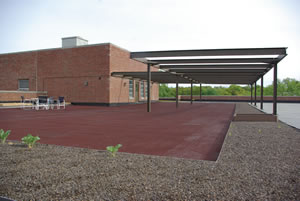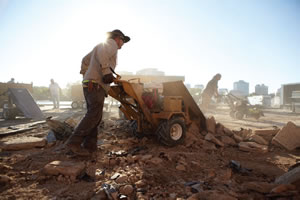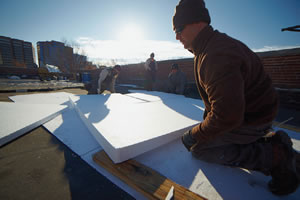Is the Roof Leaking?

PHOTOS COURTESY OF RSS ROOFING SERVICES & SOLUTIONS
Commercial roof leaks cost U.S. businesses
billions of dollars annually, causing damage that ranges
from unsightly water stains to life-threatening roof
collapse. Common for institutional facilities, flat roofing systems
are prone to leaks. Commercial roofs are typically very large with
hundreds of feet of flashing membrane seams, numerous roof
penetrations for equipment and complex drainage designs.
Failure to detect, identify and correct minor roof deterioration
and leakage at the earliest stages is considered the greatest cause
of premature roof failure. Costly roof repairs are often the result
of design deficiencies or faulty application of the roof system.
Furthermore, when properly designed and applied, all roofing
materials can still deteriorate from exposure to weather at rates
determined largely by the kind of material and the conditions of
exposure. Even new roof designs that incorporate a waterproofing
membrane are subject to potential climate damage.
There are numerous methods to detect water or moisture leaks
in a commercial roofing system, but electronic leak detection
(ELD) is the preferred, non-intrusive method. ELD is particularly
helpful in identifying defects within millimeters of accuracy,
providing targeted and effective repairs of the roofing system. ELD
is also widely used to test the installation of a new roofing system
to provide the building owner with peace of mind and confirm the
roof system’s reliability.
Methods of Leak Detection
Finding a leak is not an easy task and there are several approaches
for commercial roofs. The type of roofing system and
how the building is constructed will largely determine the best
methods for detecting leaks. Locating the source of the breach can
be very simple, or can become a process of elimination involving
multiple site visits from a professional roofing contractor. How
a roof is built plays a large role in leak detection, as some roofs
conceal the source of the leak more easily than others.
The following methods and devices can be used to detect roof leaks.
Visual Inspection
A visual examination requires a physical walk through of the
building, both inside and outside, by a roof inspector. The roof inspector
looks for obvious signs of damage, wear and failed installation.
Roof leak inspectors look for telling signs such as discoloration,
water stains and mold. Water stains often visually map the flow of
water coming from the opening. Water may simply drip through
a hole or enter the building, run across beams or trusses and drip
some distance from the initial leaking point.
Visual inspections are cost-efficient and can be easily conducted
several times throughout the year. A commercial roof leak inspector
should have thorough knowledge of many types of roof systems
and understand how other trade personnel can impact the integrity
of the roof. A roof leak may be due to another aspect of the building
envelope and not directly related to the roof installation.

PHOTOS COURTESY OF RSS ROOFING SERVICES & SOLUTIONS
HOW DO WE FIX THIS? Most facility managers prefer to replace an entire roof at a site rather
than deal with each portion of the roof individually. While a larger order of magnitude
would seem to cost less per square foot because of the cost of mobilization, the significantly
lower costs of restoration offset the substantial costs incurred in the larger project.
Infrared Thermography
Infrared thermography, also called thermal imaging, is a
non-destructive test method to detect and record temperature
differences across the surface of the roof. This type of infrared
detection has been around since the 1970s. Infrared thermography
has grown in popularity in recent years because it is less invasive
and affordable. Thermal scans are used to locate wet insulation,
which is an indicator of a failing roof system. The infrared camera captures obvious temperature differences on rooftops. As the sun
heats the roof, the wet insulation retains the warmer temperatures,
and once the atmosphere cools, the infrared camera captures the
thermal differentiation of the dry roof and wet insulation.
Infrared drones are another device that captures thermal imagery.
Infrared drones are more expensive than infrared technology
and produce similar results. This technology is particularly
beneficial when inspecting a large building because it is quicker
and allows the inspector to concentrate in more detail on the
compromised area.
Infrared detection is optimal for conditions that provide distinct
temperature differences between the interior and exterior of
the building. The prime test conditions are at night after a sunny
day and when temperatures cool quickly. The greater the rate of
outside temperature change, the greater the difference in surface
temperatures between the wet and dry areas.
Infrared thermography is not an ideal test method where there
is ponding water or any precipitation within the last 24 hours. This
test method only detects moisture in the top of the roof system, so if
there are multiple roofs on the building and moisture is trapped in
the lower roof, the scan will not detect the moisture. The lower roof
cannot attain the heat it needs to be detected by the infrared scan.
False readings can occur for roofs with ballasted systems, lightweight
concrete decks and roofs with highly reflective surfaces.
Nuclear Scans
Nuclear scans use a nuclear gauge to detect various levels
of hydrogen ions trapped within the roofing system. The readings
displayed by the gauge are a measurement of the quantity of
hydrogen ions that are present within a detectable area beneath
the gauge. Since hydrogen ions are present in water, these readings
can be correlated to moisture content once a baseline reading for a
dry area has been established. A roof inspector will establish a roof
plan before employing the nuclear scans to create a map of the wet
areas. Areas with wet insulation will have a greater concentration
of hydrogen ions than those with dry insulation.
Nuclear roof scans require a grid pattern, typically 5-foot-by-5-
foot or 10-foot-by-10-foot squares. This type of leak detection technology
can miss smaller areas of wet insulation because the actual readings
are taken on a very small portion of the total roof. The readings
only capture where the machine is placed, so if you set the machine
one inch from the wet insulation, the machine will not detect it.
Nuclear scans can be used on ballasted roof systems where
other leak detection cannot be used. Nuclear scans of larger roofs
require more time, and therefore are more costly. The scans can
be performed during the day and are not affected by debris on the
roof, winds or reflective roof coatings.
Electronic Field Vector Mapping
Electronic Field Vector Mapping (EFVM) is a leak detection
method that will pinpoint the exact area of water entry. EVFM
begins with a grounded wire loop around a given roof section,
typically 5,000 to 20,000 square feet. The technician applies water
as a conductive medium and one lead is connected to the wire loop and the other lead connects to the roof deck. Leaks are detected
when the electronic current travels across the roof membrane and
down through the breach in the deck. The technician will use two
probes to determine the exact location of the leak.
EFVM is most often used on roofs where leak detection can be
difficult due to ballasted single-pile roof systems or inverted roof
membrane assembles. The suitability of EFVM depends on the
electrical resistance of the waterproofing materials of the roofing
system. Some waterproofing membranes vary in electrical properties,
and some formulations may not be compatible.

PHOTOS COURTESY OF RSS ROOFING SERVICES & SOLUTIONS
STAYING ON TOP OF IT. In a traditional roofing program, the in-house patch-and-repair
teams or the contracted service teams are on call for leaks. This emergency response
experience is sometimes rewarding (particularly for those on the team that can truly
stop the leaks with one visit), but it is stressful for those that field the constant calls and
complaints. Under a more strategic roof management plan the leak response teams do
more preventative maintenance and less emergency response.
Maintenance and Prevention
Infrared thermography, nuclear scans and EFVM are all optimal,
nondestructive ways to help find difficult roof leaks if the technician
has been properly trained on how to operate the equipment. The
equipment has become more affordable, but it can be costly to find a
skilled technician who can perform the ELD technology successfully.
Simply being proactive in leak maintenance can keep a building
owner from spending extra costs for the ELD testing.
Additionally, a new roof does not mean that the commercial
roofing system won’t encounter leaks or damage. Roof system
maintenance is often the most neglected area of a building system.
In order to extend the life of a roofing system, conducting roof inspections
and minor repairs twice a year is recommended. Debris
should be cleaned from the gutters and roof drains and penetrations
and perimeters edges should be checked.
Scheduling routine commercial roof inspections and keeping a
close eye on common problem areas will save significant costs with
proactive management rather than paying for large-scale damage
repairs and water cleanup.
Conclusion
While there are multiple causes of commercial and institutional
roof leaks, water damage can be detrimental to the building
envelope. Detecting the source of the leak can present another set
of challenges for the building owner and it is highly advised that
the building owner schedule a roof inspection with a trusted contractor.
A highly skilled technician has the knowledge and training
to launch an inspection to identify and repair the breach. Additionally,
the technician will know what technology is best suited to
pinpoint defects in the roofing membrane, enabling targeted and
effective repairs.
This article originally appeared in the issue of .